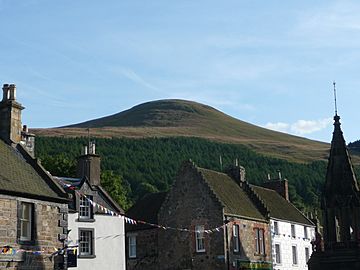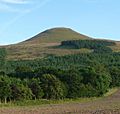Lomond Hills facts for kids
Quick facts for kids Lomond Hills |
|
|---|---|

East Lomond or Falkland Hill
|
|
| Highest point | |
| Elevation | 522 m (1,713 ft) |
| Geography | |
| Location | Fife, Scotland and Kinross-shire, Scotland |
| Climbing | |
| First ascent | Unknown |
| Easiest route | From Fife |
The Lomond Hills are a cool group of hills in central Scotland. They are sometimes called the "Paps of Fife" because of their shape. These hills are found in the western part of Fife and Perth and Kinross. The highest point is West Lomond, which stands at 522 meters (1,713 feet) tall. It's the tallest spot in Fife!
Contents
What's in a Name? The Lomond Hills Story
The name Lomond Hills was first written down in 1315 as Lomondys. It might come from an old language called Pictish. In Pictish, a word similar to llumon (from Welsh) meant "beacon." Think of a beacon as a signal fire on a hilltop!
Another idea is that the name comes from Gaelic. The words lom monadh mean "bare hill." So, the Lomond Hills could be "beacon hills" or "bare hills."
Exploring the Lomond Hills: Peaks and Valleys
The Lomond Hills have two main peaks that stand out. These are West Lomond and East Lomond, also known as Falkland Hill. East Lomond is 448 meters (1,470 feet) high. These two peaks are about 5 kilometers (3 miles) apart.
The hills have a long, steep slope called an escarpment. This slope is made of layers of sandstone, limestone, and a hard rock called quartz-dolerite. It rises sharply from the flat land below.
The peaks of East and West Lomond were formed by ancient volcanoes. Along the edges of the hills, you can see amazing rock formations. Two famous ones are the Bunnet Stane and John Knox's Pulpit. People believe that in the 1600s, groups called covenanters held secret meetings there. Another cool rock is Carlin Maggie on Bishop Hill.
Rivers and Gorges
The River Eden starts on the slopes of West Lomond. It's one of the main rivers in Fife. On the northern side of the hills, two streams, the Maspie Burn and the Arraty Burn, flow through impressive gorges. Maspie Den has a path that leads to a waterfall. Glen Vale, near West Lomond, is also a beautiful gorge.
The Rocks of the Lomond Hills: A Geological Journey
The Lomond Hills are made of different types of rocks. Many of these rocks formed a very long time ago, during the Carboniferous and Devonian periods.
The lower parts of the hills are made of old sandstone. As you go higher, you find layers of sedimentary rocks like sandstone, siltstones, and limestone.
The two main peaks, West Lomond and East Lomond, are made of tough igneous rocks. These rocks are very strong and resist erosion. This is why they stand out as high peaks.
Over time, faults (cracks in the Earth's crust) have also shaped the hills. During the last ice age, glaciers covered the area. When the ice melted, it left behind till (a mix of clay, sand, and rocks) in the lower areas. It also carved out channels where meltwater flowed.
A Look Back: History of the Lomond Hills
The Lomond Hills have a long history. You can find remains of Iron Age hill forts on the tops of East and West Lomond. There's also one at Maiden Castle, a grassy hill between the two peaks. These forts were used by people living here thousands of years ago.
In more recent times, people mined the Lomond Hills for limestone, ore, and lead. Today, there are no active mines. You can still see the remains of an old limekiln and quarry on the southwest slopes of East Lomond.
Beneath the northern slopes is Falkland Estate. This area used to be a hunting ground for the kings of Scotland when they stayed at Falkland Palace.
Fun and Nature: Recreation and Management
The Lomond Hills are a great place for outdoor activities! Because the slopes are steep and the soil isn't great for farming, the land is mostly used for sheep grazing, growing trees (commercial forestry), and collecting water. There are six reservoirs in the hills that used to supply water to towns in Fife.
The Lomond Hills are part of the Lomond Hills Regional Park. This park has rangers who work with landowners to help people enjoy the hills while protecting the environment. The park covers about 65 square kilometers (25 square miles).
Walking and Hiking
Many people love to walk and hike in the Lomond Hills. They are easy to reach from nearby towns. You can climb both East and West Lomond from Craigmead Car Park. This car park is located between the two peaks at about 300 meters (984 feet) high. Other paths start from the Bunnet Stane, the village of Falkland, and a car park high on East Lomond.
The views from the top of both peaks are amazing! You can see from the Highlands all the way to the Borders, and even the sea to the east. Because so many people walk here, the paths can get worn down. The park rangers and volunteers work hard to fix them.
Other Activities
Besides walking, you can do other fun things in the Lomonds:
- Paragliding: On windy days, you might see paragliders launching from East Lomond.
- Falkland Hill Race: This race happens every year. Runners start in Falkland village, run to the top of East Lomond, and then race back down.
- Mountain Biking: The wooded northern slopes of East Lomond have special tracks for downhill mountain biking.
- Gliding: You might also spot gliders from the Scottish Gliding Centre. They use the air currents above the hills to fly.
Gallery
-
The Lomond Hills seen from Auchtermuchty in the Howe of Fife
-
West Lomond from East Lomond
Images for kids






